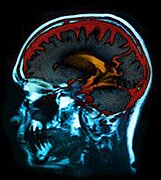
WEDNESDAY, Dec. 14 (HealthDay News) — Stroke patients suffering from a condition that prevents them from sensing or reacting to anything happening to their left — whether it’s noticing food on a plate or recognizing a person sitting to that side — may recover faster with magnetic stimulation to the nerve cells in their brain, Italian researchers report.
This inability to process and perceive stimuli on the left side of the body, called hemispatial neglect, is common after a stroke occurring on the right side of the brain, affecting up to 50 percent of patients. The researchers say that the current treatment of attention and concentration training through computer and pencil-and-paper tasks is not useful.
“This problem also affects motor function,” explained lead researcher Dr. Giacomo Koch, from the Santa Lucia Foundation in Rome. “It is important to treat not only to speed up cognitive recovery, but also motor recovery.”
Most patients recover spontaneously after about a year, he noted. The study was published in the Dec. 13 online edition of Neurology.
In the study, Koch’s team randomly assigned 20 patients with hemispatial neglect either to a sham treatment or to 10 sessions of magnetic stimulation over two weeks. All 20 patients also received conventional treatment. Patients were given tests to measure their ability to process information on the neglected side of the body.
In the technique, called transcranial magnetic stimulation, a large electromagnetic coil is placed against the patient’s scalp creating electrical currents that stimulate nerve cells.
The researchers found that patients who received the magnetic stimulation had a 16 percent improvement on the tests by the end of two weeks and a 23 percent improvement two weeks later. The test scores of patients who received the sham treatment did not improve.
The condition produces overstimulation in the left side of the brain, Koch said. Overactive brain circuits returned to normal in patients who received stimulation, but did not in those who got the sham treatment, the researchers found.
Dr. Randolph Marshall, chief of the stroke division at Columbia University Medical Center in New York City and co-author of an accompanying journal editorial, said that “scientific advances in our understanding of brain function are allowing us to develop effective ways of improving outcomes in patients who lose function as a consequence of stroke.”
“As our population ages, the total number of strokes will rise over the next 10 to 20 years,” he said. “Work like this is crucial to help improve outcomes of stroke victims.”
The brain works to a large degree by balancing excitation between the two hemispheres, Marshall said.
“A good example is directing one’s attention to one side or the other. With stroke in one side of the brain, the balance between the two cerebral hemispheres is thrown off, and the stroke victim cannot attend to one side of space,” he explained.
“Magnetic stimulation, in combination with physical therapy, reduces the over-excitability in the side of the brain opposite to where the stroke occurred,” Marshall added.
“What is important in this article is that the authors were able to demonstrate both the improvement in directed attention, and the underlying electrophysiology that allowed it to happen,” he said.
Another expert, Dr. Larry Goldstein, director of the Duke Stroke Center, expressed some caution about the findings.
“This is an interesting preliminary study,” he said. “Whether this results in a clinically meaningful improvement in ways that affect daily activities, and whether it is generalizable in other settings. requires further study,” Goldstein said.
More information
For more about stroke, visit the U.S. National Stroke Association.

